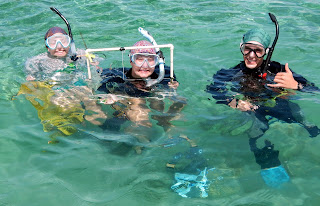
This will be the last blog post from OIMB Goes To Panama 2013.What a lot we have seen, done and learned in these past two weeks. We have worked hard, snorkeled miles, taken thousands of photos, eaten well, stretched our minds, and had a wonderful experience. Our explorations of the Caribbean Sea’s reefs, mangroves and sea grass beds have provided us a window on a world that few get to experience in the way we have been so fortunate to do.
 As one of the assignments for this course students
wrote a daily journal. With their
permission I have included some notable entries as a way to share some thoughts
of our experiences.
As one of the assignments for this course students
wrote a daily journal. With their
permission I have included some notable entries as a way to share some thoughts
of our experiences.
“I had an amazing day, it honestly felt like a
dream, snorkeling on a coral reef with colorful fish. I spent time on a Caribbean island and saw a
nurse shark in the wild. It was a great
combination of biology, fun and relaxation.
It was a bucket list day.”
 “This trip has been a growing experience for me in
so many ways. I now consider myself a
brave and experienced snorkeler and my ability to recognize reef creatures and components
has advanced beyond measure.”
“This trip has been a growing experience for me in
so many ways. I now consider myself a
brave and experienced snorkeler and my ability to recognize reef creatures and components
has advanced beyond measure.”
“I wish people could hear us when we snorkel at
night. We are always seeing cool things so
we shriek at each other through our snorkels.”
“Day one breakfast was prepared by our native born Boca del Torrosian chef, Gustavo. He is friendly and has a warm laugh. It makes me feel more comfortable and happy being here.”
.JPG) "It is one thing to read about tropical
ecosystems, but now that I have seen them up close it really makes you
appreciate them and understand the weight of environmental issues they face.”
"It is one thing to read about tropical
ecosystems, but now that I have seen them up close it really makes you
appreciate them and understand the weight of environmental issues they face.”
“Day one breakfast was prepared by our native born Boca del Torrosian chef, Gustavo. He is friendly and has a warm laugh. It makes me feel more comfortable and happy being here.”
.JPG) "It is one thing to read about tropical
ecosystems, but now that I have seen them up close it really makes you
appreciate them and understand the weight of environmental issues they face.”
"It is one thing to read about tropical
ecosystems, but now that I have seen them up close it really makes you
appreciate them and understand the weight of environmental issues they face.”
“We had a very productive morning. We set up three transect lines, but it is
much more challenging to measure out 15m, and wrap tape around a mangrove
branch while snorkeling, than you would think.”
“The Zapatillas were awesome, we saw all kinds of
corals. I really enjoyed everyone’s
attitude, everyone was calm and relaxed while snorkeling.”
There is a lot I have leaned in the past week and
a half, but I have to say I have definitely learned more about myself than
about the biology of the organisms.”
“This was my first time using a quadrat underwater
while snorkeling and it was difficult to write on the slate but it was a great
way for us to learn new species. At the start
of the snorkel I was unsure about if something was a coral, alga, or a sponge
but by the end I was much more confident in my ability to identify what I was
seeing.”
 “While I learned an incredible amount of
information about tropical marine biology and environmental issues I feel the
real life learning comes from being in a new place and pushing your comfort
zone. I may not be a fully fledged
citizen of the world yet, but Panama has definitely helped me level up.”
“While I learned an incredible amount of
information about tropical marine biology and environmental issues I feel the
real life learning comes from being in a new place and pushing your comfort
zone. I may not be a fully fledged
citizen of the world yet, but Panama has definitely helped me level up.”
We have many people to thank for this remarkable two
weeks. Our gratitude goes to the Smithsonian Institution and the staff at the
Bocas lab for hosting us so graciously in their fabulous facility. The UO’s Williams Council was instrumental in
providing the seed money that allowed us to set up this program. The UO Global Studies staff did all of the
behind the scenes work to get the program up and running. A final thanks goes to our students; they bravely
decided it was worth a gamble to sign up for a newly designed program, in
a place they had never been. It proved
to be a good choice and it has given Richard and me the opportunity to get to
know nine fine young men and women. We
have enjoyed almost every minute of living and working with them and we look
forward to seeing them go out into the world and do well.
Jan Hodder












































